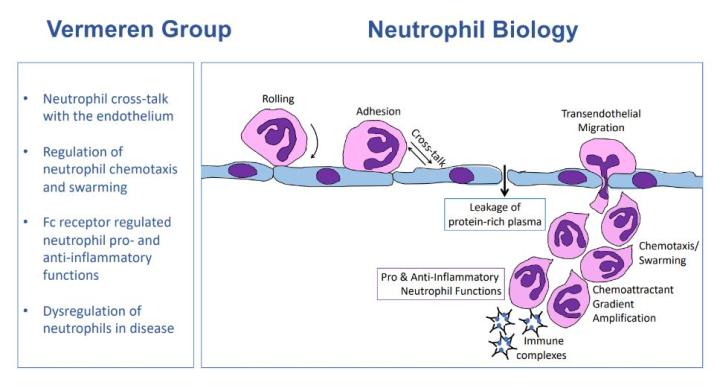Dr Sonja Vermeren
My research interest is focussed on the molecular control of pro- and anti-inflammatory neutrophil functions in health and disease and neutrophil dysregulation in disease.
Dr Sonja Vermeren
Reader

- Centre for Inflammation Research
Contact details
- Work: +44 (0)131 242 6557
- Email: sonja.vermeren@ed.ac.uk
- Web: Academic Profile
Group Members
- Caroline Pumpe
- Jiaqi Shen
- Yihui Liu
- Elizabeth Krull
Background
Neutrophils are the most abundant circulating leucocytes in humans. Neutrophilic inflammation is critical for effective immune responses to infection, but must be tightly controlled to prevent host tissue injury. To perform their essential functions, neutrophils follow chemical guidance cues, migrating through the vessel wall and then through the body’s tissue to reach inflammatory sites. They ingest small pathogens which they kill intracellularly using cytotoxic compounds and reactive oxygen species released into a phagosome. Alternatively, these compounds may be released extracellularly, e.g. for extracellular killing, but also promoting host injury. Neutrophil extracellular traps, decondensed strands of chromatin decorated with cytotoxic proteins are also involved in extracellular killing as well as promoting host injury.
Research Overview
We are interested in the molecular control of specialised neutrophils functions and how these are dysregulated in disease.
- Neutrophil cross-talk with the endothelium to regulate transendothelial migration and inflammation-associated leakage of protein-rich plasma fluid. How are cell-cell adhesion processes controlled?

- Regulation of neutrophil chemotaxis and, relatedly, swarming to inflammatory sites
- Pro- and anti-inflammatory neutrophil functions induced after stimulation with infectious agents (e.g. bacteria) and sterile stimuli (e.g. immune complexes)
- Dysregulation of neutrophils in disease, in particular, autoimmune disease such as rheumatoid arthritis and also liver cirrhosis. What causes neutrophil dysregulation, and (how) do dysregulated neutrophils promote disease? What is the involvement of other immune and non-immune cells?
These questions are addressed using a combination of approaches and experimental models.

You can view a full catalogue of graphical research summaries for each group in the Centre for Inflammation Research by visiting our Research page.
Biographical Profile
Sonja undertook PhD training in biochemistry at the University of Cambridge and post-doctoral training in cell biology at the MRC Laboratory for Molecular Cell Biology, London and the Babraham Institute, Cambridge. She set up her own laboratory at the Babraham Institute, working on neutrophils and endothelial cells. She moved to the Centre for Inflammation Research at the University of Edinburgh in 2013 where she is currently a Reader. Her main research interest lies on molecular control of neutrophil pro- and anti-inflammatory functions and their dysregulation in disease.
Honours and Awards
- Boehringer Ingelheim Fellowship 1996-1999
- Deutsche Forschungsgemeinschaft Research Fellowship 2001-2002
- BBSRC David Phillips Fellowship 2006-2011
- Chancellor's Fellowship 2013-2018
Other Responsibilites
- Chair of CIR Postgraduate Studies Committee (2022 - )
- Chair of CIR Blood Resource Management Committee (2021 - )
- Member of CIR Management Committee (2021 - )
- Member of CIR Postgraduate Committee (2019 - )
- Member of Athena SWAN OCS sub-committee (2014-19)
- Member of Animal Welfare Committee (2013-18)
- Member of 3Rs committee (2023 - )
- BBSRC Pool of Experts (2023 - )
- Section Editor, The Journal of Immunology (2021 - )
- Guest Editor, Frontiers in Immunology (2020-21)
- Member of the Organising Committee for Neutrophil 2020
Alumni
- Kruthika Sundaram (2019-22, Post-doc. Moved to a local Biotech company)
- Melina Michael (2017-21, PhD student. Now a post-doc at University College London)
- Waywen Loh (2022, BSc Honours project student; now a graduate student at the University of Oxford)
- Luca Kovacs (2022, Intercalated medic)
- Jiahui Lin (2021-22, MSc student, moved to a biotech company)
- Utsa Karmakar (2017-21, PhD student. Now a post-doc in the CIR)
- Julia Chu (2013-2021, MSc, then PhD student, then post-doc. Moved to the Babraham Institute, Cambridge as senior post-doc)
- Emma Turner (2021, Intercalated medic)
- Sevgi Cavusoglu (2020, BSc Honours project student. Moved to COVID Lighthouse Lab)
- Barry McCormick (2016-19, post-doc. Moved to the University of Highlands and Islands as senior post-doc)
- Irina Balazs (2019, academic visitor. Returned to Medical University Graz, Austria)
- Hannah Garside (2019 Intercalated medic)
- Emily Robson (2018-19, MSc student, became research assistant at the University of Edinburgh)
- Eva Crespo (2018, MSc student, moved to University of Glasgow as PhD student)
- Greta Mazelyte (2018, BSc Honours project student)
- Jade Sheil (2017, BSc Honours project student)
- Janina Nahler (2016, BSc Honours project student, moved to University of Oxford as PhD student)
- Eleanor Burns (2016, BSc Honours project student, trained to be a science teacher)
- Marta Canel (2015-16, Post-doc, moved to another post-doc at University of Edinburgh)
- Matilda Toivakka (2014-15, MSc student, then PhD student at University of Edinburgh)
- Florian Wollweber (2014-15, MSc student, then PhD student at Freiburg University, Germany)
- Jia Yunxiang (2014, MSc student, went on to do an MBA)
Sources of Funding
Biotechnology and Biological Sciences Research Council
More information on funding at Sonja Vermeren's Research Explorer profile.

